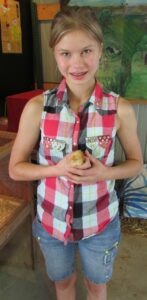Hatching eggs bring new life this spring

By Emily Hanlin
Winnebago-Boone Farm Bureau Ag Communications
BOONE COUNTY – In the week prior to Easter, I am willing to bet you and your family partook in some fun holiday traditions. Maybe you colored some eggs. Maybe you visited the Easter Bunny at the mall.
Have you ever thought about why we celebrate Easter with a bunny and eggs when everyone knows bunnies do not lay eggs?
Well, except the Cadbury bunny of course.
I’m not sure why these two traditions go hand in hand; it doesn’t really make sense to this farm girl. However, I do know that here at the Farm Bureau, Easter time means lots of eggs. Not color ones though, eggs in an incubator ready to hatch.
This time of year, many of the programs provided by Winnebago-Boone Ag in the Classroom (AITC) engage students in the poultry industry by hatching chicks in classrooms.
I remember my second grade teacher doing a similar lesson where we witnessed chicks hatching in class. I recall this being one of my favorite activities and programs in school. It aided to spark my interest in agriculture and who doesn’t love those cute fluffy babies?
The AITC lends out incubators and “Chick Kits” to classrooms in the local area. Students learn the details of the embryo development and the hatching process. The kit includes lessons on chick hatching as well as all of the supplies needed to care for newly hatched chicks.
During my time at the Farm Bureau, I have learned the tips and tricks needed to know while hatching chicks.
To ensure optimal fertility, eggs should be stored at room temperature pointy end down, rotated daily, and be less than seven days old.
 Never handle eggs roughly or with dirty hands.To protect their health and hygiene use clean, dry hands and a gentle touch.
Never handle eggs roughly or with dirty hands.To protect their health and hygiene use clean, dry hands and a gentle touch.
Some people have the opportunity to pick up fertile directly from the farm gate.
However, if you order fertile eggs through the mail, like we do at the Farm Bureau, they will need to be kept still (pointy end down) for 12 to 24 hours to settle the air cells prior to being set in the incubator. No matter where you get them, you should allow the eggs to warm to room temperature (70 to 80°F) for 24 hours before you set them in the incubator.
One very important aspect of this process is appropriate location of the incubator. Since temperature control is the single most important factor to successfully hatching chicks from eggs, you need to protect your incubator from extreme temperatures in the immediate environment.
You should locate your incubator in a room where it is out of direct sunlight, away from drafts and shielded somewhat from outside temperatures by placing it near an inside wall. Preferably, room temperature should be a reasonably steady 70 to 75° F.
The absolute most noteworthy things to keep in mind during this process are temperature, humidity, ventilation, and turning. While these factors are all important, the most critical of these is temperature, followed by humidity.
Effectively hatching chicks that are healthy is determined completely by maintaining a controlled environment for the whole length of incubation.
Although we try our best with the most efficient practices possible, the hatching rate in an incubator does not match the hatching rate of a momma hen doing what she does best, caring for and loving on her babies until they are ready to face the world on their own.
Maybe we can all learn a little something from momma hen and get back to the most important aspect of any day: spending time loving our friends and family.



